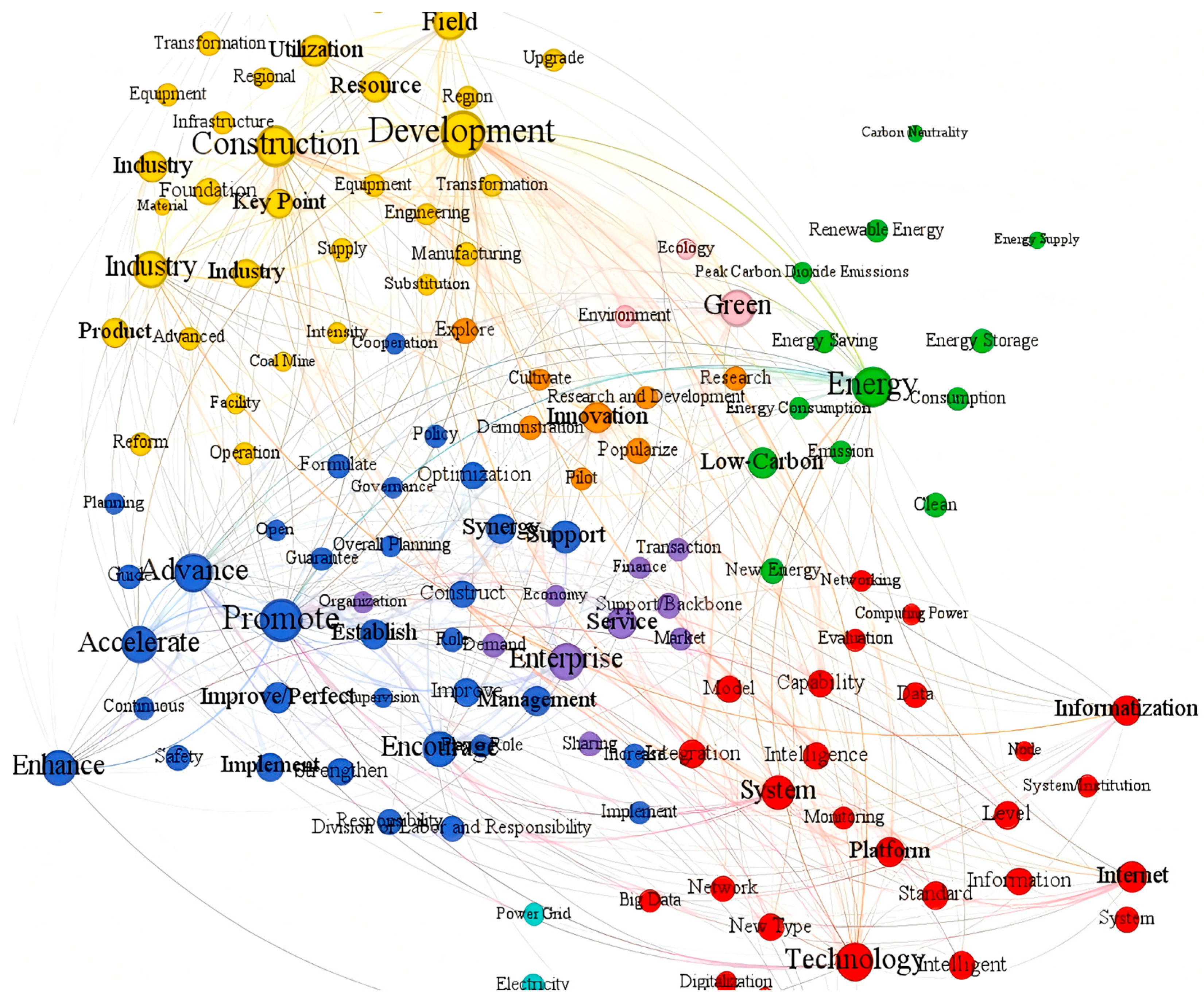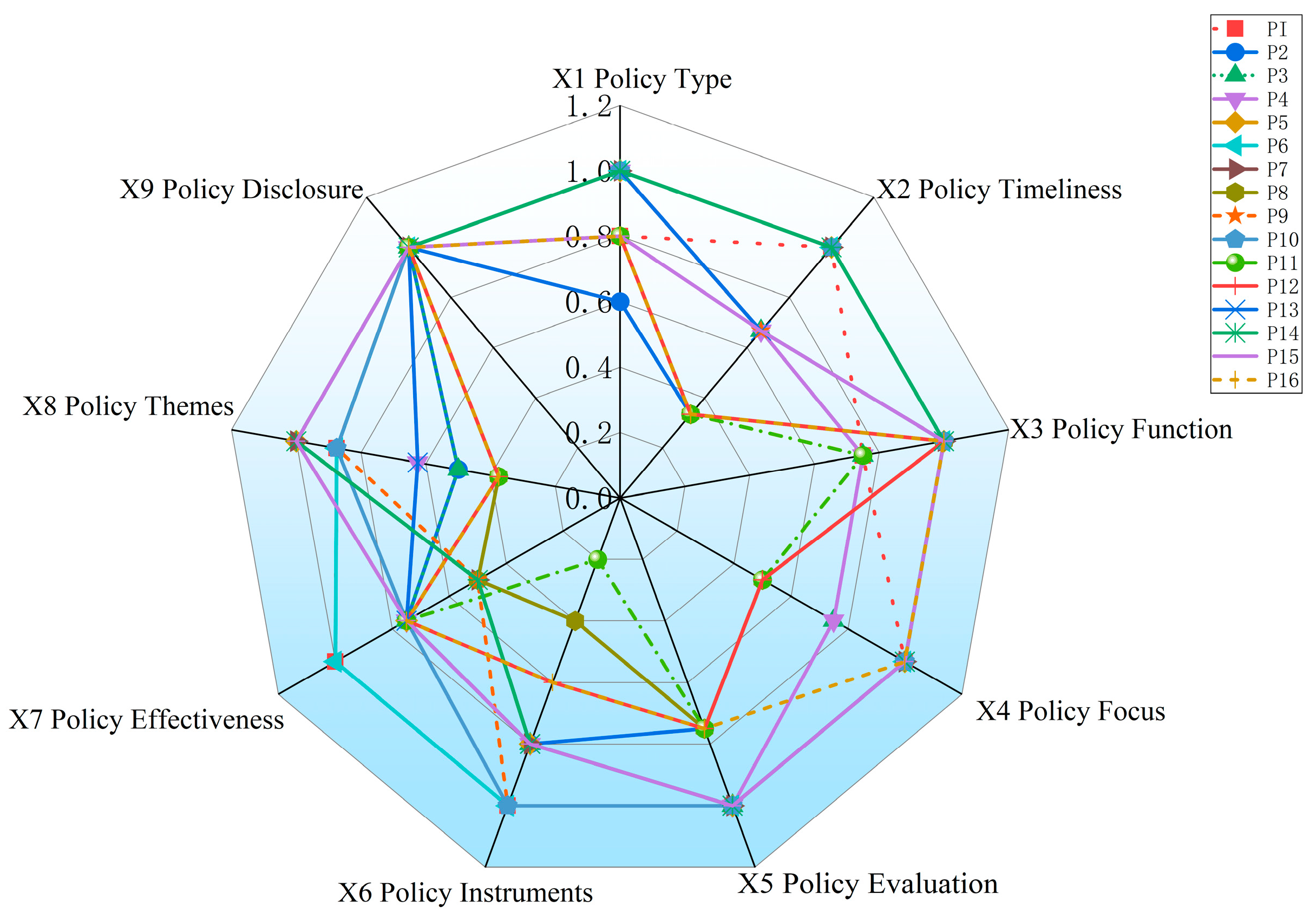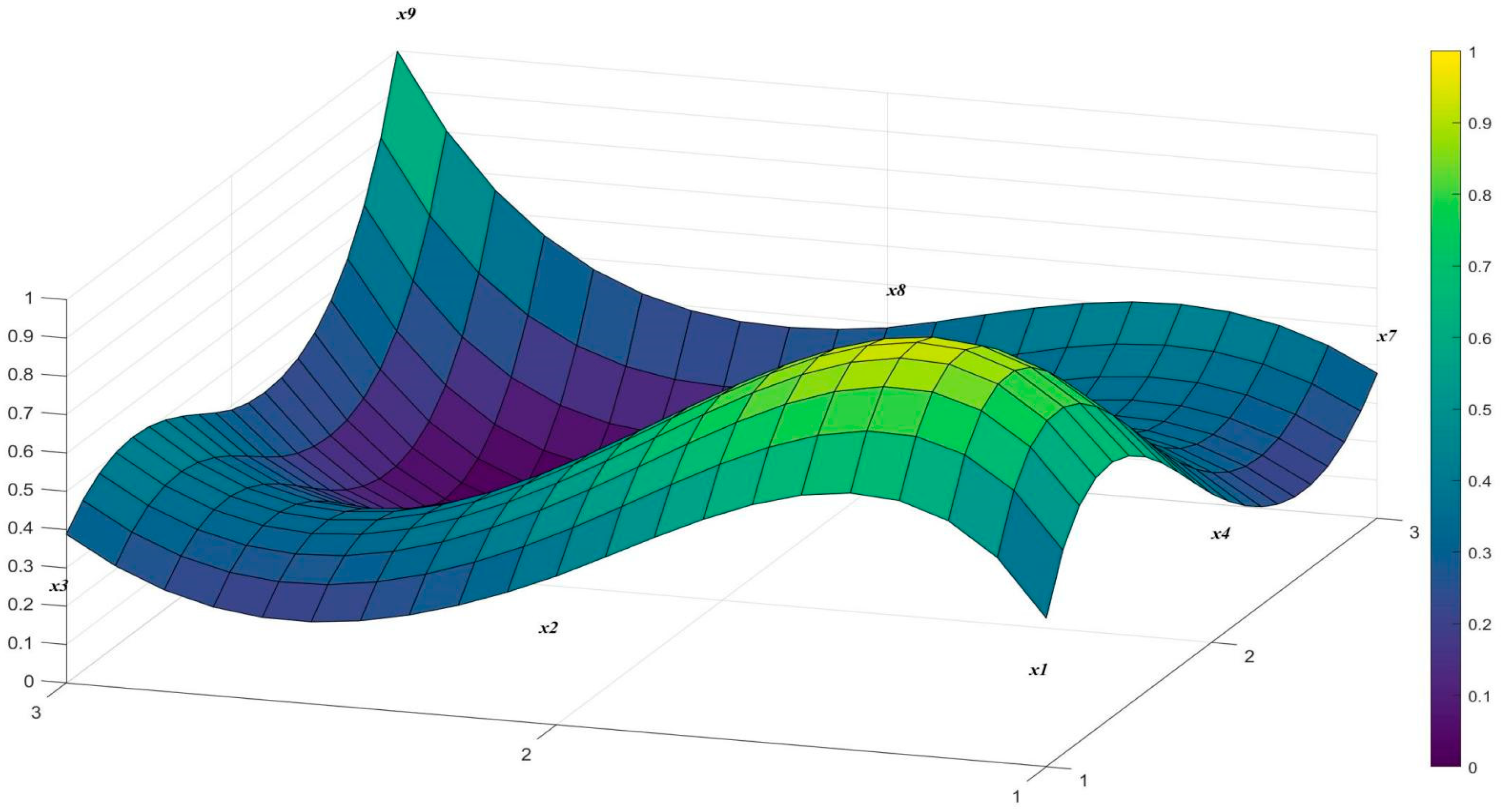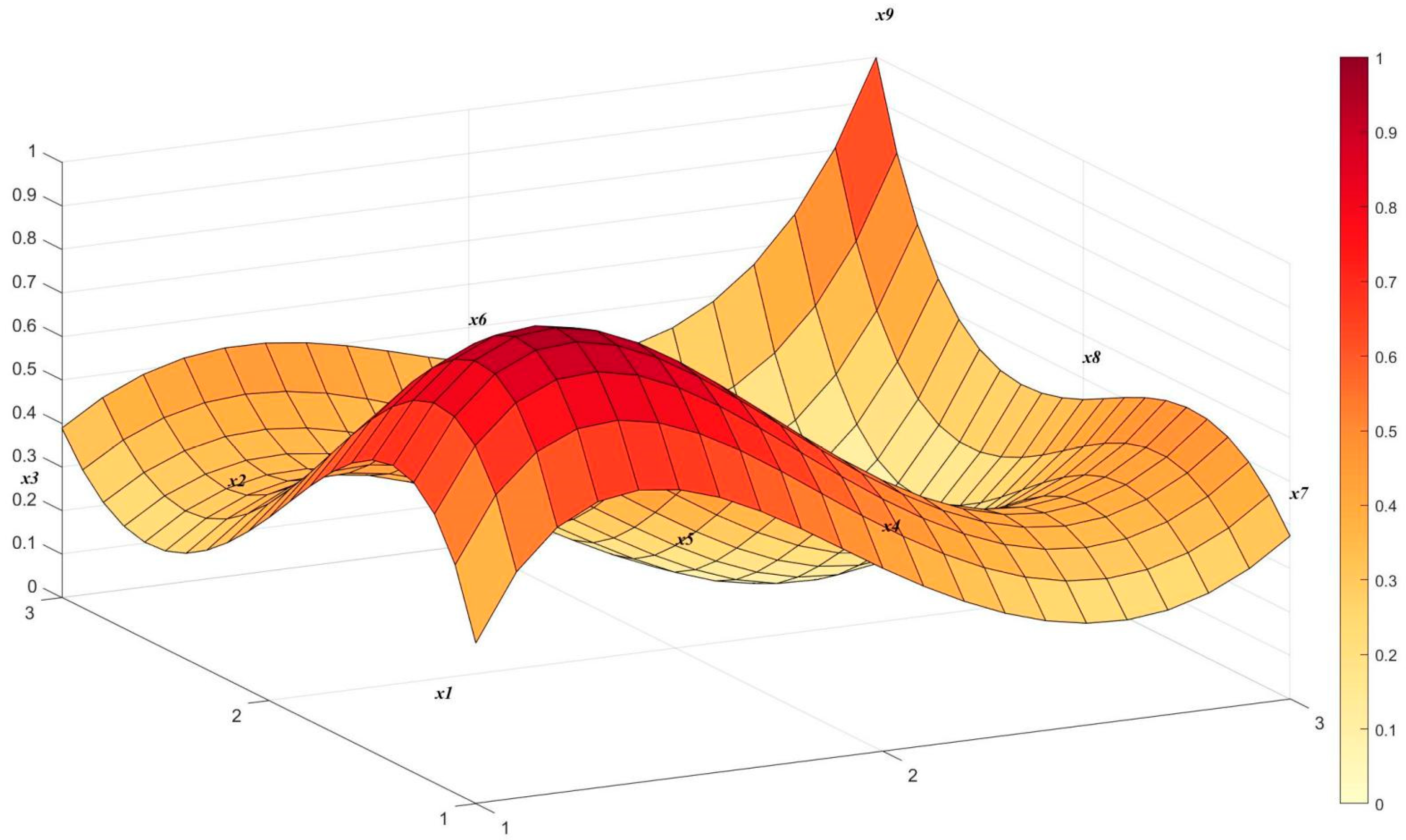China’s Smart Energy Policy Evaluation Based on Policy Modelling Consistency Index
Abstract
1. Introduction
2. Literature Review
2.1. The Evolution and Meaning of Smart Energy
2.2. Theoretical Foundations and Applications of the PMC Index Model
3. Methods
3.1. Data Collection
3.2. Construction of the PMC Index Model
- (1)
- Policy Text Mining Analysis
- (2)
- Semantic network topic clustering analysis
3.3. Variable Classification and Parameter Identification
4. Results and Discussion
5. Conclusions
5.1. Strengthening Policy Timeliness Management
5.2. Diversify Policy Instruments
5.3. Enhance Thematic Focus and Cross-Sectoral Coherence
5.4. Methodological Limitations and Future Improvements
Author Contributions
Funding
Data Availability Statement
Conflicts of Interest
Appendix A
| Label | Closnesscentrality | Harmonicclosnesscentrality | Betweenesscentrality | Cluster Categories | Cluster Themes | Cluster Colors |
|---|---|---|---|---|---|---|
| Wisdom | 0 | 0 | 0 | Technology and Digitalization | 1 | Red |
| Energy | 0 | 0 | 0 | Energy and Carbon Emissions | 4 | Green |
| Internet | 0.569231 | 0.63964 | 0.002659 | Technology and Digitalization | 1 | Red |
| Industry | 0.521127 | 0.558559 | 0.000007 | Industry and Manufacturing | 3 | Yellow |
| Product | 0.510345 | 0.542793 | 0 | Industry and Manufacturing | 3 | Yellow |
| Enterprise | 0.643478 | 0.727477 | 0.004247 | Market and Economy | 6 | Purple |
| Optimization | 0.517483 | 0.542793 | 0 | Management and Governance | 2 | Blue |
| Low-Carbon | 0.548148 | 0.592342 | 0.002846 | Energy and Carbon Emissions | 4 | Green |
| System | 0.596774 | 0.666667 | 0.001866 | Technology and Digitalization | 1 | Red |
| Role | 0.468354 | 0.486486 | 0.008316 | Management and Governance | 2 | Blue |
| Supply | 0 | 0 | 0 | Industry and Manufacturing | 3 | Yellow |
| Guarantee | 0.4625 | 0.477477 | 0 | Management and Governance | 2 | Blue |
| Information | 0.528571 | 0.572072 | 0.000076 | Technology and Digitalization | 1 | Red |
| Informatization | 0.560606 | 0.612613 | 0.005031 | Technology and Digitalization | 1 | Red |
| Energy Storage | 0.440476 | 0.46509 | 0 | Energy and Carbon Emissions | 4 | Green |
| Advanced | 0 | 0 | 0 | Industry and Manufacturing | 3 | Yellow |
| Sharing | 0 | 0 | 0 | Market and Economy | 6 | Purple |
| Renewable Energy | 0.430233 | 0.451577 | 0 | Energy and Carbon Emissions | 4 | Green |
| Division of Labor and Responsibility | 0.397849 | 0.433559 | 0 | Management and Governance | 2 | Blue |
| Innovation | 0.560606 | 0.617117 | 0.000329 | Research and Innovation | 5 | Orange |
| Utilization | 0.560606 | 0.612613 | 0.00019 | Industry and Manufacturing | 3 | Yellow |
| Formulate | 0 | 0 | 0 | Management and Governance | 2 | Blue |
| System/Institution | 0 | 0 | 0 | Technology and Digitalization | 1 | Red |
| Manufacturing | 0.474359 | 0.490991 | 0 | Industry and Manufacturing | 3 | Yellow |
| Intensity | 1 | 1 | 0 | Industry and Manufacturing | 3 | Yellow |
| Increase | 1 | 1 | 0 | Management and Governance | 2 | Blue |
| Accelerate | 0.666667 | 0.754505 | 0.006749 | Management and Governance | 2 | Blue |
| Regional | 0 | 0 | 0 | Industry and Manufacturing | 3 | Yellow |
| Upgrade | 0 | 0 | 0 | Industry and Manufacturing | 3 | Yellow |
References
- Liang, X.; Ma, L.; Chong, C.; Li, Z.; Ni, W. Development of Smart Energy Towns in China: Concept and Practices. Renew. Sustain. Energy Rev. 2020, 119, 109507. [Google Scholar] [CrossRef]
- Munonye, W.C. Circular Economy Meets Smart Energy Grids: Designing Systems for Resource Optimization and Carbon Reduction. Front. Sustain. 2025, 6, 1568254. [Google Scholar] [CrossRef]
- Razmjoo, A.; Mirjalili, S.; Aliehyaei, M.; Østergaard, P.A.; Ahmadi, A.; Nezhad, M.M. Development of Smart Energy Systems for Communities: Technologies, Policies and Applications. Energy 2022, 248, 123540. [Google Scholar] [CrossRef]
- Ceglia, F.; Marrasso, E.; Pallotta, G.; Roselli, C.; Sasso, M. The State of the Art of Smart Energy Communities: A Systematic Review of Strengths and Limits. Energies 2022, 15, 3462. [Google Scholar] [CrossRef]
- Billanes, J.; Enevoldsen, P. Influential Factors to Residential Building Occupants? Acceptance and Adoption of Smart Energy Technologies in Denmark. Energy Build. 2022, 276, 112524. [Google Scholar] [CrossRef]
- Große-Kreul, F. What Will Drive Household Adoption of Smart Energy? Insights from a Consumer Acceptance Study in Germany. Util. Policy 2022, 75, 101333. [Google Scholar] [CrossRef]
- Gimpel, H.; Graf, V.; Graf-Drasch, V. A Comprehensive Model for Individuals’ Acceptance of Smart Energy Technology—A Meta-Analysis. Energy Policy 2020, 138, 111196. [Google Scholar] [CrossRef]
- Vasseur, V.; Marique, A.-F.; Udalov, V. A Conceptual Framework to Understand Households’ Energy Consumption. Energies 2019, 12, 4250. [Google Scholar] [CrossRef]
- Vindegg, M.; Julsrud, T.E. Digitised Demand Response in Practice: The Role of Digital Housekeeping for Smart Energy Technologies. Energy Effic. 2025, 18, 1. [Google Scholar] [CrossRef]
- Brown, A.; Hampton, H.; Foley, A.; Del Rio, D.F.; Lowans, C.; Caulfield, B. Understanding Domestic Consumer Attitude and Behaviour Towards Energy: A Study on the Island of Ireland. Energy Policy 2023, 181, 113693. [Google Scholar] [CrossRef]
- Ennemiri, N.; Emrani, A.; Abdelmajid, J.; El Mrabet, R.; Berrada, A. Medium-Term Forecast of Multi-Energy Photovoltaic/Biogas/Battery System’s Operation Adopting Smart Energy Management Strategy. Clean Technol. Environ. Policy 2025, 27, 2247–2268. [Google Scholar] [CrossRef]
- Yu, S.; Mascherbauer, P.; Haupt, T.; Skorna, K.; Rickmann, H.; Kochanski, M.; Kranzl, L. Modeling Households’ Behavior, Energy System Operation, and Interaction in the Energy Community. Energy 2025, 328, 136338. [Google Scholar] [CrossRef]
- Campana, P.; Censi, R.; Ruggieri, R.; Amendola, C. Smart Grids and Sustainability: The Impact of Digital Technologies on the Energy Transition. Energies 2025, 18, 2149. [Google Scholar] [CrossRef]
- Szpilko, D.; Fernando, X.; Nica, E.; Budna, K.; Rzepka, A.; Lăzăroiu, G. Energy in Smart Cities: Technological Trends and Prospects. Energies 2024, 17, 6439. [Google Scholar] [CrossRef]
- Rogge, K.S.; Schleich, J. Do Policy Mix Characteristics Matter for Low-Carbon Innovation? A Survey-Based Exploration of Renewable Power Generation Technologies in Germany. Res. Policy 2018, 47, 1639–1654. [Google Scholar] [CrossRef]
- Rogge, K.S.; Dütschke, E. What Makes Them Believe in the Low-Carbon Energy Transition? Exploring Corporate Perceptions of the Credibility of Climate Policy Mixes. Environ. Sci. Policy 2018, 87, 74–84. [Google Scholar] [CrossRef]
- Johnstone, P.; Kivimaa, P. Multiple Dimensions of Disruption, Energy Transitions and Industrial Policy. Energy Res. Soc. Sci. 2018, 37, 260–265. [Google Scholar] [CrossRef]
- Han, B.; Bompard, E.; Profumo, F.; Xia, Q. Paths toward Smart Energy: A Framework for Comparison of the Eu and China Energy Policy. IEEE Trans. Sustain. Energy 2014, 5, 423–433. [Google Scholar] [CrossRef]
- Hou, M. Current Status, Challenges, and Countermeasures for China’s Energy Transition and Energy Security under the Carbon Neutrality Goal. J. Southwest Pet. Univ. (Nat. Sci. Ed.) 2023, 45, 1–10. [Google Scholar]
- Heiskanen, E.; Kivimaa, P.; Lovio, R. Promoting Sustainable Energy: Does Institutional Entrepreneurship Help? Energy Res. Soc. Sci. 2019, 50, 179–190. [Google Scholar] [CrossRef]
- Envall, F. Situated Dynamics of Environmental Governance in Swedish Smart Energy Experimentation: Tentativeness, Demonstration, Upscaling. Environ. Plan. C Politics Space 2023, 41, 922–940. [Google Scholar] [CrossRef]
- Mlecnik, E.; Parker, J.; Ma, Z.; Corchero, C.; Knotzer, A.; Pernetti, R. Policy Challenges for the Development of Energy Flexibility Services. Energy Policy 2020, 137, 111147. [Google Scholar] [CrossRef]
- Matschoss, K.; Mikkonen, I.; Gynther, L.; Koukoufikis, G.; Uihlein, A.; Murauskaite-Bull, I. Drawing Policy Insights from Social Innovation Cases in the Energy Field. Energy Policy 2022, 161, 112728. [Google Scholar] [CrossRef]
- O’Dwyer, E.; Pan, I.; Acha, S.; Shah, N. Smart Energy Systems for Sustainable Smart Cities: Current Developments, Trends and Future Directions. Appl. Energy 2019, 237, 581–597. [Google Scholar] [CrossRef]
- Biresselioglu, M.E.; Nilsen, M.; Demir, M.H.; Røyrvik, J.; Koksvik, G. Examining the Barriers and Motivators Affecting European Decision-Makers in the Development of Smart and Green Energy Technologies. J. Clean. Prod. 2018, 198, 417–429. [Google Scholar] [CrossRef]
- Biresselioglu, M.E.; Solak, B.; Savas, Z.F. Unveiling Resistance and Opposition against Low-Carbon Energy Transitions: A Comprehensive Review. Energy Res. Soc. Sci. 2024, 107, 103354. [Google Scholar] [CrossRef]
- Fell, M.J.; Vigurs, C.; Maidment, C.; Shipworth, D. Smart Local Energy Systems as a Societal Project: Developing a Theory of Change. Smart Energy 2023, 11, 100109. [Google Scholar] [CrossRef]
- Oliveira, S.; Chatzimichali, A.; Atkins, E.; Badarnah, L.; Moghaddam, F.B. From Individuals to Collectives in Energy Systems—A Social Practice, Identity and Rhythm Inspired Lens. Energy Res. Soc. Sci. 2023, 105, 103279. [Google Scholar] [CrossRef]
- Royapoor, M.; Allahham, A.; Hosseini, S.H.R.; Rufa’i, N.A.; Walker, S.L. Towards 2050 Net Zero Carbon Infrastructure: A Critical Review of Key Decarbonization Challenges in the Domestic Heating Sector in the Uk. Energy Sources Part B Econ. Plan. Policy 2023, 18, 2272264. [Google Scholar] [CrossRef]
- Dong, M.; Li, C.; Sampene, A.K. Exploring the Impact of Green Finance, Technological Innovation, Mineral Resources, and Carbon Tax on the Green Energy Transition. Smart Energy 2025, 19, 100189. [Google Scholar] [CrossRef]
- Zhou, A.; Wang, S.; Chen, B. Impact of New Energy Demonstration City Policy on Energy Efficiency: Evidence from China. J. Clean. Prod. 2023, 422, 138560. [Google Scholar] [CrossRef]
- Tang, J.; Zhao, P.; Gao, Y. Can Smart Energy Alleviate Energy Poverty in China? -Empirical Evidence Using Synthetic Control Methods. J. Clean. Prod. 2024, 449, 141821. [Google Scholar] [CrossRef]
- Icaza-Alvarez, D.; Jurado, F.; Tostado-Véliz, M. Smart Energy Planning for the Decarbonization of Latin America and the Caribbean in 2050. Energy Rep. 2024, 11, 6160–6185. [Google Scholar] [CrossRef]
- Moradi, M.A.; Salimi, M.; Amidpour, M. Evaluation of Agriculture Wells Electrification Policy and Development of a Long-Term Sustainable Energy Strategy. Smart Energy 2023, 10, 100101. [Google Scholar] [CrossRef]
- Buyle, M.; Galle, W.; Debacker, W.; Audenaert, A. Sustainability Assessment of Circular Building Alternatives: Consequential Lca and Lcc for Internal Wall Assemblies as a Case Study in a Belgian Context. J. Clean. Prod. 2019, 218, 141–156. [Google Scholar] [CrossRef]
- Tomić, T.; Kremer, I.; Schneider, D.R. Economic Efficiency of Resource Recovery-Analysis of Time-Dependent Changes on Sustainability Perception of Waste Management Scenarios. Clean Technol. Environ. Policy 2022, 24, 543–562. [Google Scholar] [CrossRef]
- Cheng, Q.; Chen, Z.; Lin, M.; Wang, H. Quantitative Evaluation of China’s Energy Supply Policies in the ‘13th Five--Year Plan’ Period (2016–2020): A Pmc Index Modelling Approach Incorporating Text Mining. Energy Sci. Eng. 2024, 12, 596–616. [Google Scholar] [CrossRef]
- Dolge, K.; Vicmane, L.K.; Bohvalovs, G.; Blumberga, D. Energy Transition Reality Check: Are Municipalities Meeting the Mark? Sci. J. Riga Technol. Univ. Environ. Clim. Technol. 2024, 28, 394–408. [Google Scholar] [CrossRef]
- Dolge, K.; Gravelsins, A.; Vicmane, L.K.; Blumberga, A.; Blumberga, D. What Drives Energy Storage Deployment in Local Energy Transitions? Stakeholders’ Perspective. Smart Energy 2024, 15, 100146. [Google Scholar] [CrossRef]
- Tzani, D.; Exintaveloni, D.S.; Stavrakas, V.; Flamos, A. Devising Policy Strategies for the Deployment of Energy Efficiency Pay-for-Performance Programmes in the European Union. Energy Policy 2023, 178, 113593. [Google Scholar] [CrossRef]
- González-López, R.; Giampietro, M. Relational Analysis of the Oil and Gas Sector of Mexico: Implications for Mexico’s Energy Reform. Energy 2018, 154, 403–414. [Google Scholar] [CrossRef]
- Siakas, D.; Rahanu, H.; Georgiadou, E.; Siakas, K.; Lampropoulos, G. Positive Energy Districts Enabling Smart Energy Communities. Energies 2025, 18, 3131. [Google Scholar] [CrossRef]
- Grimmer, J.; Stewart, B.M. Text as Data: The Promise and Pitfalls of Automatic Content Analysis Methods for Political Texts. Political Anal. 2013, 21, 267–297. [Google Scholar] [CrossRef]
- Laver, M.; Benoit, K.; Garry, J. Extracting Policy Positions from Political Texts Using Words as Data. Am. Political Sci. Rev. 2003, 97, 311–331. [Google Scholar] [CrossRef]
- Quinn, K.M.; Monroe, B.L.; Colaresi, M.; Crespin, M.H.; Radev, D.R. How to Analyze Political Attention with Minimal Assumptions and Costs. Am. J. Political Sci. 2010, 54, 209–228. [Google Scholar] [CrossRef]
- Ma, H.; Zhang, T. Insights for China from the Patterns of Low-Carbon Technology Innovation Adoption and Application in Countries Leading the Way to Carbon Peaking: An Analysis Based on the “Technology-Organization-Environment” Framework. Mod. Econ. Explor. 2023, 7, 15–22. [Google Scholar]
- Rogge, K.S.; Reichardt, K. Policy Mixes for Sustainability Transitions: An Extended Concept and Framework for Analysis. Res. Policy 2016, 45, 1620–1635. [Google Scholar] [CrossRef]
- Howlett, M.; Wellstead, A.M. Policy Analysts in the Bureaucracy Revisited: The Nature of Professional Policy Work in Contemporary Government. Politics Policy 2011, 39, 613–633. [Google Scholar] [CrossRef]
- Estrada, M.A.R. Policy Modeling: Definition, Classification and Evaluation. J. Policy Model. 2011, 33, 523–536. [Google Scholar] [CrossRef]
- Ruiz Estrada, M.A. An Alternative Graphical Modeling for Economics: Econographicology. Qual. Quant. 2017, 51, 2115–2139. [Google Scholar] [CrossRef]
- Stewart, J.; Ayres, R. Systems Theory and Policy Practice: An Exploration. Policy Sci. 2001, 34, 79–94. [Google Scholar] [CrossRef]
- Xia, Y. Quantitative Evaluation of Digital Economy Policies in the Tourism Industry Using the Tf-Idf and Pmc Index Model. IEEE Access 2024, 12, 189636–189650. [Google Scholar] [CrossRef]
- Geng, R.-Q.; Wu, J. Assess the Efficacy of China’s Inter-Provincial Government Services Policy: A Quantitative Evaluation Based on Pmc-Index Model. PLoS ONE 2024, 19, e0310491. [Google Scholar] [CrossRef]
- Shen, H.; Xiong, P.; Yang, L.; Zhou, L. Quantitative Evaluation of Science and Technology Financial Policies Based on the Pmc-Ae Index Model: A Case Study of China’s Science and Technology Financial Policies since the 13th Five-Year Plan. PLoS ONE 2024, 19, e0307529. [Google Scholar] [CrossRef] [PubMed]
- Awewomom, J.; Dzeble, F.; Takyi, Y.D.; Ashie, W.B.; Ettey, E.N.Y.O.; Afua, P.E.; Sackey, L.N.A.; Opoku, F.; Akoto, O. Addressing Global Environmental Pollution Using Environmental Control Techniques: A Focus on Environmental Policy and Preventive Environmental Management. Discov. Environ. 2024, 2, 8. [Google Scholar] [CrossRef]
- Shi, Q.; Yu, J.; Zhang, L.; Wang, J.; Cheng, G. Quantitative Evaluation of Smart Construction Pilot Cities Policies in China Based on the Pmc-Index Model. Eng. Constr. Arch. Manag. 2024; ahead-of-print. [Google Scholar] [CrossRef]
- Ernesto, E. The Structure of Complex Networks: Theory and Applications; American Chemical Society: Columbus, OH, USA, 2012. [Google Scholar]
- Kuang, B.; Han, J.; Lu, X.; Zhang, X.; Fan, X. Quantitative Evaluation of China’s Cultivated Land Protection Policies Based on the Pmc-Index Model. Land Use Policy 2020, 99, 105062. [Google Scholar] [CrossRef]
- Dai, Y.; Chen, X. Evaluating Green Financing Mechanisms for Natural Resource Management: Implications for Achieving Sustainable Development Goals. Resour. Policy 2023, 86, 104160. [Google Scholar] [CrossRef]





| No. | Name | Issuing Authority | Year |
|---|---|---|---|
| 1 | Guiding Opinions on Vigorously Implementing Renewable Energy Substitution Actions | National Development and Reform Commission of China | 2024 |
| 2 | Opinions on Leveraging Green Finance to Serve the Construction of a Beautiful China | People’s Bank of China; Ministry of Ecology and Environment | 2024 |
| 3 | Notice on Promoting the Development of the Mobile Internet of Things “Intelligent Connectivity of Everything” | General Office of the Ministry of Industry and Information Technology of China | 2024 |
| 4 | Implementation Opinions on Deeply Implementing the “East Data, West Computing” Project and Accelerating the Construction of a Nationwide Integrated Computing Network | National Development and Reform Commission of China | 2023 |
| 5 | Several Opinions on Accelerating the Digitalization and Intelligent Development of Energy | National Energy Administration of China | 2023 |
| 6 | Notice on the Implementation Plan for Carbon Peak in the Industrial Sector | National Development and Reform Commission of China | 2022 |
| 7 | 14th Five-Year Plan for a Modern Energy System | National Development and Reform Commission of China | 2022 |
| 8 | Implementation Opinions on Deepening Reform of “Streamline Administration, Delegate Power, Strengthen Regulation, and Improve Services” and Optimizing the Business Environment in the Energy Sector | National Energy Administration of China | 2021 |
| 9 | 14th Five-Year Plan for Green Industrial Development | General Office of the Minis-try of Industry and Information Technology of China | 2021 |
| 10 | Guiding Opinions on Accelerating the Development of New Energy Storage | National Development and Reform Commission of China | 2021 |
| 11 | Guiding Opinions on Accelerating the Establishment of a New Standard System in the Energy Sector | National Energy Administration of China | 2020 |
| 12 | Opinions on Accelerating the Establishment of a Legal and Policy Framework for Green Production and Consumption | National Development and Reform Commission of China | 2020 |
| 13 | Guiding Opinions on Accelerating the Smart Development of Coal Mines | National Energy Administration of China | 2020 |
| 14 | Strategy for the Revolution in Energy Production and Consumption (2016–2030) | National Energy Administration of China | 2016 |
| 15 | Guiding Opinions on Promoting the Development of “Internet+” Smart Energy | National Development and Reform Commission of China | 2016 |
| 16 | Guiding Opinions on Actively Advancing the “Internet+” Initiative | State Council of the People’s Republic of China | 2015 |
| Word | Frequency | Word | Frequency | Word | Frequency | Word | Frequency |
|---|---|---|---|---|---|---|---|
| Energy | 770 | Sector | 198 | Carbon | 124 | Coal Mine | 100 |
| Green | 540 | Intelligent | 195 | Level | 124 | Policy | 98 |
| Development | 516 | Low-carbon | 191 | Capability | 122 | Exploration | 96 |
| Construction | 355 | Utilization | 187 | Integration | 122 | Energy Saving | 96 |
| Promotion | 345 | Resource | 175 | New Type | 120 | Consumption | 92 |
| Internet | 345 | Production | 171 | Security | 118 | Promotion | 92 |
| Technology | 305 | Focus | 161 | Manufacturing | 115 | Finance | 92 |
| Enterprise | 302 | Country | 160 | Model | 113 | New Energy | 91 |
| Advancement | 270 | Establishment | 156 | Improvement | 113 | Electricity | 91 |
| Industry | 266 | Energy Storage | 154 | Informatization | 112 | Reform | 89 |
| Service | 246 | Mechanism | 153 | Foundation | 112 | Clean | 87 |
| System | 237 | Improvement | 152 | Data | 112 | Transaction | 87 |
| Field | 231 | Industry | 150 | Optimization | 110 | Demonstration | 87 |
| Standard | 228 | Information | 150 | Network | 110 | Guarantee | 86 |
| Support | 222 | Product | 144 | Reinforcement | 109 | Emission | 83 |
| Encouragement | 221 | Synergy | 142 | Renewable Energy | 108 | Region | 82 |
| Innovation | 220 | Computing Power | 139 | Efficiency | 107 | Formulation | 81 |
| Acceleration | 212 | Implementation | 136 | System | 104 | Research | 80 |
| Enhancement | 210 | Management | 136 | Construction | 102 | Equipment | 80 |
| Intelligence | 205 | Platform | 132 | Market | 100 | Guidance | 77 |
| Primary Variables | Secondary Variables | Evaluation Criteria | References |
|---|---|---|---|
| Policy Type (X1) | (X1:1) Prediction | Whether the policy is predictive | Literature Support |
| (X1:2) Regulation | Whether the policy involves regulatory content | ||
| (X1:3) Recommendation | Whether the policy is advisory | ||
| (X1:4) Description | Whether the policy contains descriptive content | ||
| (X1:5) Guidance | Whether the policy has a guiding role | ||
| Policy Timeliness (X2) | (X2:1) Long-term | Whether the policy involves long-term content (over 10 years) | Literature Support |
| (X2:2) Medium-term | Whether the policy involves medium-term content (5–10 years) | ||
| (X2:3) Short-term | Whether the policy involves short-term content (1–5 years) | ||
| Policy Function (X3) | (X3:1) Encouragement and support | Whether the policy involves providing encouragement | Literature Support |
| (X3:2) Normative guidance | Whether the policy involves normative guidance | ||
| (X3:3) Systemic constraints | Whether the policy involves systemic constraints | ||
| (X3:4) Service optimization | Whether the policy involves service optimization | ||
| Policy Focus (X4) | (X4:1) Green low-carbon transition | Whether the policy involves development of clean energy and carbon reduction | High-frequency word statistics |
| (X4:2) Technological innovation | Whether the policy involves promoting the upgrading of the energy industry through scientific and technological progress | ||
| (X4:3) Industrial development | Whether the policy involves importance on energy infrastructure construction | ||
| (X4:4) Digital transformation | Whether the policy involves shift from traditional energy to smart energy | ||
| Policy Evaluation (X5) | (X5:1) Sufficient basis | Whether the policy basis is sufficient | Literature Support |
| (X5:2) Clear objectives | Whether the policy objectives are clear | ||
| (X5:3) Planned implementation | Whether the policy is based on planned implementation | ||
| (X5:4) Scientific approach | Whether the policy approach is scientific | ||
| Policy Instruments (X6) | (X6:1) Material incentives | Whether the policy involves material incentives | Literature Support |
| (X6:2) Financial assistance | Whether the policy involves financial assistance | ||
| (X6:3) Technical support | Whether the policy involves technical support | ||
| (X6:4) Policy constraints | Whether the policy involves mandatory provisions | ||
| (X6:5) Investment Promotion | Whether the policy involves investment initiatives | ||
| Policy Effectiveness (X7) | (X7:1) Action plan | Whether the policy involves an action plan | Literature Support |
| (X7:2) Guiding outline | Whether the policy involves a guiding outline | ||
| (X7:3) Implementation standards | Whether the policy involve implementation standards | ||
| (X7:4) Notice or opinion | Whether the policy involves a notice or opinion | ||
| Policy Themes (X8) | (X8:1) Technology and Digitalization | Whether the policy theme includes technological innovation | Network Semantic Analysis |
| (X8:2) Management and Governance | Whether the policy theme involves the government’s guiding role in smart energy development | ||
| (X8:3) Industry and Manufacturing | Whether the policy theme involves smart energy’s upgrading and transformation of traditional energy | ||
| (X8:4) Energy and Carbon Emissions | Whether the policy theme involves smart energy serving the national carbon reduction strategy | ||
| (X8:5) Research and Innovation | Whether the policy theme involves innovation-driven characteristics of smart energy development | ||
| (X8:6) Market and Economy | Whether the policy theme involves the construction of a commercial ecosystem for smart energy | ||
| (X8:7) Ecology and Environment | Whether the policy theme involves green development and environmental | ||
| (X8:8) Infrastructure | Whether the policy theme includes infrastructure support | ||
| Policy Disclosure (X9) | (X9:1) Policy Disclosure | Whether the policy disclosed |
| Policy Dimension | PI | P2 | P3 | P4 | P5 | P6 | P7 | P8 |
|---|---|---|---|---|---|---|---|---|
| Policy Type (X1) | 0.80 | 0.60 | 1.00 | 1.00 | 1.00 | 1.00 | 1.00 | 0.80 |
| Policy Timeliness (X2) | 1.00 | 0.33 | 0.67 | 0.67 | 1.00 | 1.00 | 1.00 | 0.33 |
| Policy Function (X3) | 0.75 | 1.00 | 0.75 | 0.75 | 1.00 | 1.00 | 1.00 | 1.00 |
| Policy Focus (X4) | 1.00 | 0.50 | 0.75 | 0.75 | 1.00 | 1.00 | 1.00 | 0.50 |
| Policy Evaluation (X5) | 1.00 | 0.75 | 1.00 | 1.00 | 1.00 | 1.00 | 1.00 | 0.75 |
| Policy Instruments (X6) | 1.00 | 0.80 | 0.80 | 0.80 | 0.80 | 1.00 | 0.80 | 0.40 |
| Policy Effectiveness (X7) | 1.00 | 0.75 | 0.75 | 0.75 | 0.75 | 1.00 | 0.50 | 0.50 |
| Policy Themes (X8) | 0.88 | 0.50 | 0.50 | 0.63 | 1.00 | 0.88 | 1.00 | 0.38 |
| Policy Disclosure (X9) | 1.00 | 1.00 | 1.00 | 1.00 | 1.00 | 1.00 | 1.00 | 1.00 |
| PMC Index | 8.43 | 6.23 | 7.22 | 7.34 | 8.55 | 8.88 | 8.30 | 5.66 |
| Policy Effectiveness Level | Excellent | Good | Excellent | Excellent | Excellent | Excellent | Excellent | Good |
| Policy Dimension | P9 | P10 | P11 | P12 | P13 | P14 | P15 | P16 |
| Policy Type (X1) | 1.00 | 1.00 | 0.80 | 0.80 | 1.00 | 1.00 | 0.80 | 0.80 |
| Policy Timeliness (X2) | 0.67 | 1.00 | 0.33 | 0.33 | 0.67 | 1.00 | 0.67 | 0.33 |
| Policy Function (X3) | 1.00 | 1.00 | 0.75 | 1.00 | 1.00 | 1.00 | 1.00 | 1.00 |
| Policy Focus (X4) | 1.00 | 1.00 | 0.50 | 0.50 | 1.00 | 1.00 | 1.00 | 1.00 |
| Policy Evaluation (X5) | 1.00 | 1.00 | 0.75 | 0.75 | 1.00 | 1.00 | 1.00 | 0.75 |
| Policy Instruments (X6) | 1.00 | 1.00 | 0.20 | 0.60 | 0.80 | 0.80 | 0.80 | 0.60 |
| Policy Effectiveness (X7) | 0.50 | 0.75 | 0.75 | 0.75 | 0.75 | 0.50 | 0.75 | 0.75 |
| Policy Themes (X8) | 0.88 | 0.88 | 0.38 | 0.38 | 0.63 | 1.00 | 1.00 | 0.38 |
| Policy Disclosure (X9) | 1.00 | 1.00 | 1.00 | 1.00 | 1.00 | 1.00 | 1.00 | 1.00 |
| PMC Index | 8.04 | 8.63 | 5.46 | 6.11 | 7.84 | 8.30 | 8.02 | 6.61 |
| Policy Effectiveness Level | Excellent | Excellent | Good | Good | Excellent | Excellent | Excellent | Good |
| Score | 0–4.99 | 5–6.99 | 7–8.99 | 9–10 |
|---|---|---|---|---|
| Evaluation | Poor | Average | Good | Excellent |
| Dimension | Mean Score | SD | Min | Max | Performance Ranking |
|---|---|---|---|---|---|
| X9: Policy Disclosure | 1.000 | 0.000 | 1.00 | 1.00 | 1 |
| X3: Policy Function | 0.938 | 0.096 | 0.75 | 1.00 | 2 |
| X5: Policy Evaluation | 0.922 | 0.114 | 0.75 | 1.00 | 3 |
| X1: Policy Type | 0.900 | 0.125 | 0.60 | 1.00 | 4 |
| X4: Policy Focus | 0.844 | 0.215 | 0.50 | 1.00 | 5 |
| X6: Policy Instruments | 0.763 | 0.226 | 0.20 | 1.00 | 6 |
| X7: Policy Effectiveness | 0.703 | 0.145 | 0.50 | 1.00 | 7 |
| X8: Policy Themes | 0.703 | 0.250 | 0.38 | 1.00 | 8 |
| X2: Policy Timeliness | 0.688 | 0.277 | 0.33 | 1.00 | 9 |
Disclaimer/Publisher’s Note: The statements, opinions and data contained in all publications are solely those of the individual author(s) and contributor(s) and not of MDPI and/or the editor(s). MDPI and/or the editor(s) disclaim responsibility for any injury to people or property resulting from any ideas, methods, instructions or products referred to in the content. |
© 2025 by the authors. Licensee MDPI, Basel, Switzerland. This article is an open access article distributed under the terms and conditions of the Creative Commons Attribution (CC BY) license (https://creativecommons.org/licenses/by/4.0/).
Share and Cite
Cai, R.; Zhang, T.; Wang, X.; Zhao, S.; Yang, H.; Geng, Q. China’s Smart Energy Policy Evaluation Based on Policy Modelling Consistency Index. Energies 2025, 18, 5339. https://doi.org/10.3390/en18205339
Cai R, Zhang T, Wang X, Zhao S, Yang H, Geng Q. China’s Smart Energy Policy Evaluation Based on Policy Modelling Consistency Index. Energies. 2025; 18(20):5339. https://doi.org/10.3390/en18205339
Chicago/Turabian StyleCai, Rongjiang, Tao Zhang, Xi Wang, Shufang Zhao, Hang Yang, and Qixiang Geng. 2025. "China’s Smart Energy Policy Evaluation Based on Policy Modelling Consistency Index" Energies 18, no. 20: 5339. https://doi.org/10.3390/en18205339
APA StyleCai, R., Zhang, T., Wang, X., Zhao, S., Yang, H., & Geng, Q. (2025). China’s Smart Energy Policy Evaluation Based on Policy Modelling Consistency Index. Energies, 18(20), 5339. https://doi.org/10.3390/en18205339






